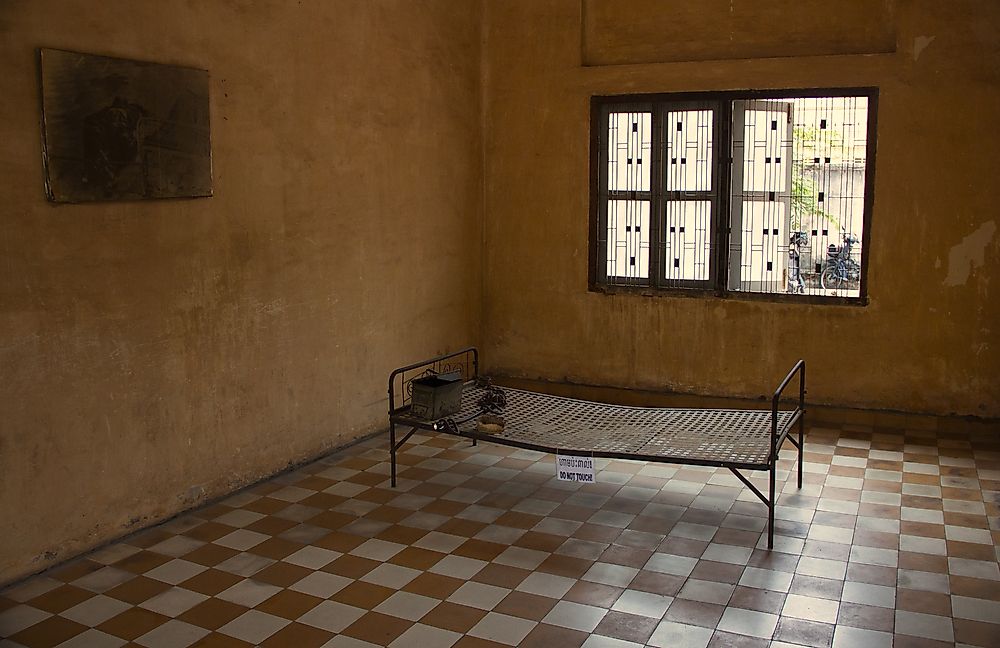Who was Pol Pot?

Pol Pot ruled Cambodia as its Prime Minister from 1976 to 1979 and was instrumental in the deaths of millions of Cambodians. Together with the Khmer Rouge (Cambodia’s communist party), he worked to shift Cambodia to a classless agrarian society. Pol Pot and the Khmer Rouge sent people to detention centers and introduced harsh and inhumane policies that brought much suffering to the people. The inhumane treatment was focused especially on intellectuals, religious leaders, and those who lived in urban centers. Millions of Cambodians died from torture, execution, starvation, disease, and forced labor.
Early Life
Pol Pot was born Saloth Sar in May 1925 in Prek Sbauv, a small village about 100 miles from Phnom Penh. Compared to the national average, his parents were relatively wealthy. Sar spent time in a Buddhist monastery and then was enrolled by his parents in a French Catholic primary school. During this time, he lived with his brother and his family. Sar was held back two years. In 1949, he received a scholarship to go to Paris and study radio electronics. In Paris, he joined a communist movement known as the "Marxist Circle". Sar was very drawn to Stalin’s approach to Marxism and was influenced also by Mao’s writings. In December 1952, he volunteered to return to Cambodia and assess which organization the "Marxist Circle" should support.
Rise to Power
When Pol Pot returned to Cambodia in 1953, the country was already in revolt against its French colonial rule; within the year, Cambodia would gain its independence. He led an underground communist group referred to as the Khmer People’s Revolutionary Party (KPRP). From 1956 to 1963, Pol Pot taught at a private school in Phnom Penh and increased the Khmer Rouge’s membership and influence over the years. In 1963, he fled to rural areas in Northern Cambodia, so as to avoid police capture. There, he established guerrilla camps to fight the government led by Sihanouk. In 1968, he and the Khmer Rouge army began their advance in the remote villages of Cambodia. The movement was a slow one. It was not until April 1975 that Pol Pot led the Khmer Rouge army into Phnom Penh, ending the civil war. Immediately, Pol Pot took leadership of Cambodia. He was determined to build a new Cambodia and adopted the concept of year zero.
Time in Power
As leader of the Khmer Rouge, Pol became the de facto ruler of the country when Phnom Penh was overtaken. In January of 1976, Cambodia adopted a new constitution and changed its name to Democratic Kampuchea. Pol Pot was elected as prime minister in April of that year. Under Pol Pot and the Khmer Rouge rule, the country took an agrarian approach. His goal was for Cambodia to become a self-reliant communist nation sustained solely by agriculture. He abolished religion, money, ownership of private property and selected books. Pol Pot was also against Westernization. Academics, government officials, Buddhist monks, and traders were executed under his command. Many intellectuals and educated civil servants were sent to the fields to participate in a “re-education” process. The evacuation of Phnom Penh was one of the first steps in this process. Its nearly 2 million residents were sent to the rural areas of the country. Anyone who complained or broke the rules was forced to a detention center. Many people working in the farms died due to overwork. Thousands of others starved to death.
Ongoing Legacy
The Khmer Rouge regime under the leadership of Pol Pot is said to have been the most brutal regime of the 20th century. Close to 3 million people are said to have died between 1975 and 1979 when he ruled. Pol Pot eventually fled Cambodia after the Khmer Rouge were overthrown. He died in the jungle on April 15, 1998, where he had been placed under house arrest for his crimes against humanity and was about to be handed to an international tribunal.











